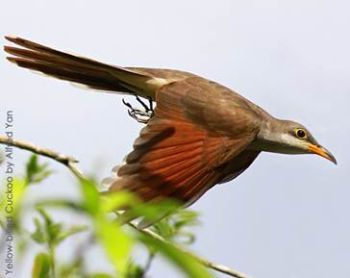
Publisher:
Bonnie King
CONTACT:
Newsroom@Salem-news.com
Advertising:
Adsales@Salem-news.com

~Truth~
~Justice~
~Peace~
TJP
Dec-07-2013 13:49

 TweetFollow @OregonNews
TweetFollow @OregonNews
Threatened Listing Proposal Not Enough to Conserve Western Yellow-billed Cuckoo
Salem-News.comAggressive Habitat Protection, Ending Threats from Tower Collisions and Pesticides Urgently Needed
 Yellow-billed Cuckoo |
(WASHINGTON, DC) - American Bird Conservancy (ABC), one of the nation's leading bird conservation groups, says that the U.S. Fish and Wildlife Service (FWS) proposal to list the western population of the Yellow-billed Cuckoo as a threatened species under the Endangered Species Act falls short of providing the necessary protections for the imperiled bird species whose numbers have plummeted in recent decades.
The ABC assertions are contained in a December 2 letter to FWS available here.
"The draft rule only proposes to list the species as threatened rather than as endangered, and doesn’t address the threats or propose more effective conservation measures such as removing cattle from riparian areas and restricting the use of pesticides in adjacent agricultural areas,” said Steve Holmer, senior policy advisor with American Bird Conservancy.
"Federal agencies must address water diversion and grazing policies that are disastrous to the cuckoo. They need to reverse direction, stop the degradation, and develop a plan to restore riparian areas and regrow lost Yellow-billed Cuckoo habitat," Holmer added.
In the United States, only 350 to 495 pairs of the bird exist, with a similar number found in Mexico. The birds are isolated in small patches of increasingly degraded riparian forest habitat.
The draft rule says that collisions with towers during migration and pesticide impacts are significant threats to the remaining western Yellow-billed Cuckoos. "In addition to working with farmers and ranchers, ABC urges that a program be adopted to educate and provide financial incentives for tower owners within the species' range to adopt modern lighting known to reduce Yellow-billed Cuckoo deaths," said Holmer. "Pesticide use also must be restricted in Yellow-billed Cuckoo critical habitat."
The species has been extirpated or nearly so from most of its historical range across portions of 12 western states as well as British Columbia. There have been no recent sightings in Oregon, Washington, or Montana. In California, the population is estimated to be less than one percent of its probable historic size. Very small populations of less than 10 pairs exist in Nevada, Wyoming, Colorado, and Texas, and in Idaho and Utah only an estimated 10 to 20 pairs remain.
Only in a portion of the species’ range in Arizona, New Mexico, California, and Mexico do significant populations remain, but the trend continues to be downward. The extent of the cuckoo’s riparian habitat loss is extreme: 90 to 95 percent in Arizona, 90 percent in New Mexico, and 90 to 99 percent in California. In Arizona, the state with largest U.S. cuckoo population, numbers have declined 70 to 80 percent in the past 30 years.
"The draft rule finds there is ongoing degradation and habitat loss, and concludes that these impacts are anticipated to continue for decades to come,” said Holmer. "New management standards and regulatory mechanisms to protect and restore the cuckoo's habitat are urgently needed."
The draft rule also raises serious concern about the land management policies of two federal agencies—the Bureau of Land Management and the USDA Forest Service—stating: "BLM and USFS have discretion in how these [environmental protection] statues are carried out and measures are implemented … we continue to see continued loss and degradation of habitat for the western Yellow-billed Cuckoo on lands that these agencies manage."
A March 2013 report by American Bird Conservancy suggests that pesticide use may have implications for the cuckoo population. It found that a single corn kernel coated with a neonicotinoid, now the most widely used class of pesticides in the world, can kill a songbird. Even a tiny grain of wheat or canola treated with the oldest neonicotinoid, imidacloprid, can fatally poison a bird. As little as one-tenth of a neonicotinoid-coated corn seed per day during egg-laying season is all that is needed to affect reproduction.
As long-distance, nocturnal migrants, Yellow-billed Cuckoos are vulnerable to collisions with tall buildings, cell towers, radio antennas, wind turbines, and other structures. The cuckoos are known to be attracted to lights that can lead to fatal collisions. An ABC report documenting bird deaths at towers found evidence of a total of 568 Yellow-billed Cuckoo deaths at 17 towers.
Researchers have found that by extinguishing the steady-burning red lights on towers, nighttime bird fatality rates can be reduced by more than 70 percent. Birds are not as likely to be attracted to and collide with towers that are lit with only red flashing lights or white flashing lights. In December 2011, the Federal Communications Commission agreed on interim changes to their system for approving applications for new telecommunication towers.
There is also concern about the potential for western Yellow-billed Cuckoos to collide with wind turbines. ABC’s comment letter urges the FWS to provide a more detailed analysis of the risk to the species posed by the current and expected build-out of wind turbines.
American Bird Conservancy (ABC) is a 501(c)(3) not-for-profit membership organization whose mission is to conserve native birds and their habitats throughout the Americas. ABC acts by safeguarding the rarest species, conserving and restoring habitats, and reducing threats, while building capacity in the bird conservation movement.
 |
 |
 |
Articles for December 6, 2013 | Articles for December 7, 2013 | Articles for December 8, 2013
Salem-News.com:





Terms of Service | Privacy Policy
All comments and messages are approved by people and self promotional links or unacceptable comments are denied.
[Return to Top]
©2026 Salem-News.com. All opinions expressed in this article are those of the author and do not necessarily reflect those of Salem-News.com.